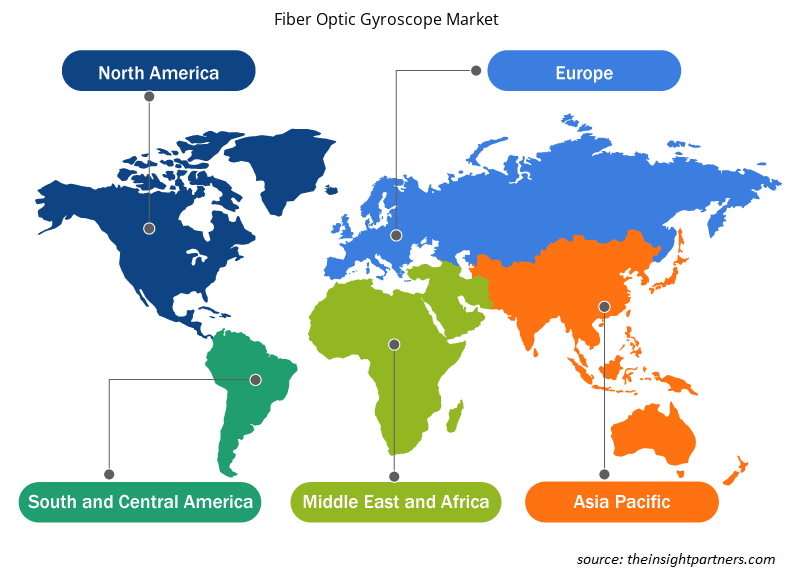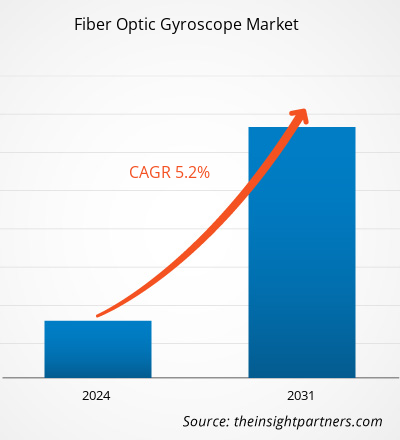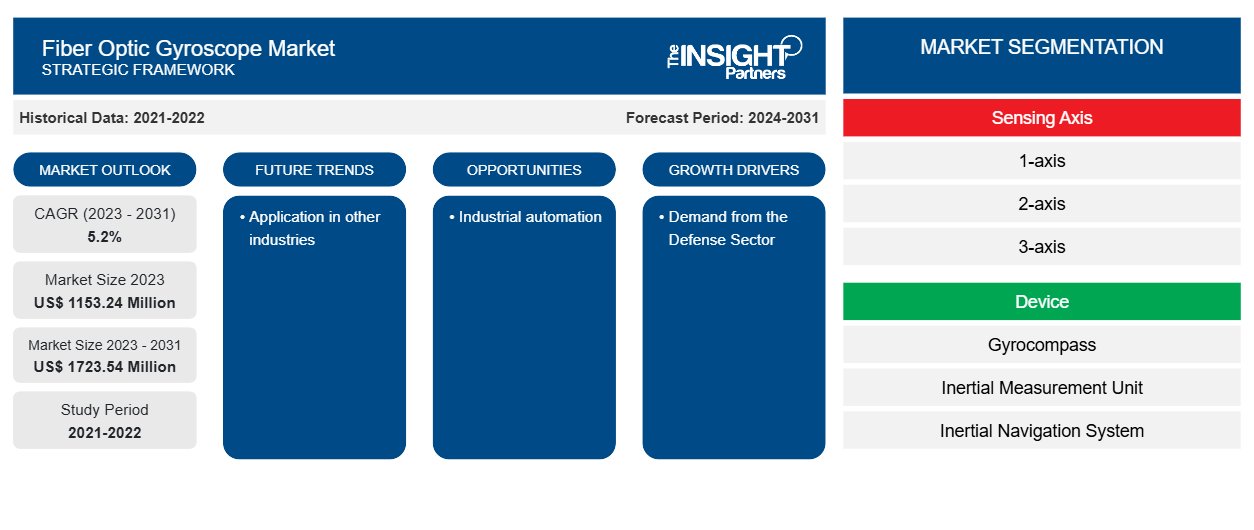Se proyecta que el tamaño del mercado de giroscopios de fibra óptica alcance los 1723,54 millones de dólares estadounidenses en 2031, frente a los 1153,24 millones de dólares estadounidenses en 2023. Se espera que el mercado registre una CAGR del 5,2 % entre 2023 y 2031. Es probable que el aumento del gasto militar y los beneficios que ofrece el giroscopio de fibra óptica sigan siendo tendencias clave del mercado de giroscopios de fibra óptica.
Análisis del mercado de giroscopios de fibra óptica
Debido a los diversos beneficios de los giroscopios de fibra óptica, como su pequeño tamaño, peso ligero, bajo consumo de energía, larga vida útil, alta confiabilidad y producción en masa, varios sectores, como el aeroespacial y de defensa, los sectores industriales y otros, demandan giroscopios de fibra óptica. Por lo tanto, sus demandas de varios sectores fomentan el crecimiento de su mercado. Además, el crecimiento del gasto militar en todo el mundo debido al enfoque del gobierno en el fortalecimiento de su sector militar alimenta la demanda de giroscopios de fibra óptica en aplicaciones de guía de vehículos operados a distancia.
Descripción general del mercado de giroscopios de fibra óptica
Un giroscopio de fibra óptica se utiliza para medir la velocidad angular, que se utiliza en diversas aplicaciones que van desde la navegación de misiles hasta el control de movimiento. Los giroscopios de fibra óptica tienen varias ventajas sobre otros tipos de giroscopios, entre ellas, su peso ligero, su tamaño pequeño, su larga vida útil, su bajo consumo de energía, su alta fiabilidad y su producción en masa. Para la navegación, la guía y el control de misiles, aviones, robots, automóviles, naves espaciales, etc., es una herramienta especialmente importante.
Personalice este informe según sus necesidades
Obtendrá personalización en cualquier informe, sin cargo, incluidas partes de este informe o análisis a nivel de país, paquete de datos de Excel, así como también grandes ofertas y descuentos para empresas emergentes y universidades.
-
Obtenga las principales tendencias clave del mercado de este informe.Esta muestra GRATUITA incluirá análisis de datos, desde tendencias del mercado hasta estimaciones y pronósticos.
Impulsores y oportunidades del mercado de giroscopios de fibra óptica
Demanda del sector de defensa por parte de los actores del mercado para favorecer el mercado
Varios beneficios de los giroscopios de fibra óptica, que incluyen una alta velocidad de rotación y alta resolución en comparación con sus sustitutos, como las alternativas, como los giroscopios mecánicos y los giroscopios láser de anillo, impulsan su adopción en el sector de defensa. Debido a sus beneficios, los actores del mercado reciben pedidos que impulsan el mercado de giroscopios de fibra óptica. Por ejemplo, en agosto de 2021, KVH Industries, Inc. (Nasdaq: KVHI), anunció que había recibido un pedido de giroscopios de fibra óptica (FOG) por US$ 7,9 millones de Escribano, un contratista de defensa español para su nueva torreta de control remoto Guardian 30.KVH Industries, Inc. (Nasdaq: KVHI), announced that it had received a US$ 7.9 million fiber optic gyro (FOG) order from Escribano, a Spanish defense contractor for its new Guardian 30 remotely controlled turret.
Aplicación en otras industrias: una oportunidad en el mercado de giroscopios de fibra óptica
Los giroscopios de fibra óptica se desarrollaron originalmente para aplicaciones militares y de defensa; sin embargo, debido a sus posibles beneficios sobre los otros tipos de giroscopios, también se han adoptado ampliamente en otras industrias, incluidos los sectores comerciales e industriales de todo el mundo. También existe una rápida demanda de giroscopios de fibra óptica en las industrias automotriz, médica y robótica. La creciente demanda de soluciones tecnológicamente avanzadas para mejorar la eficiencia operativa en varias industrias y la creciente tendencia a la automatización industrial están impulsando aún más la demanda de giroscopios de fibra óptica.
Análisis de segmentación del informe de mercado de giroscopios de fibra óptica
Los segmentos clave que contribuyeron a la derivación del análisis del mercado de giroscopios de fibra óptica son el eje de detección, el dispositivo y la aplicación.
- Según el eje de detección, el mercado se segmenta en 1 eje, 2 ejes y 3 ejes. El segmento de 3 ejes tuvo una mayor participación de mercado en 2023.
- Por dispositivo, el mercado se segmenta en brújulas giroscópicas, unidades de medición inercial, sistemas de navegación inercial y sistemas de referencia de actitud y rumbo. El segmento de unidades de medición inercial tuvo la mayor participación del mercado en 2023.
- Por aplicación, el mercado está segmentado en aplicaciones de grado táctico, guía de vehículos operados a distancia, aeronáutica y aviación, robótica y defensa y seguridad nacional. El segmento de defensa y seguridad nacional tuvo la mayor participación del mercado en 2023.
Análisis de la cuota de mercado de giroscopios de fibra óptica por geografía
El alcance geográfico del informe de mercado del giroscopio de fibra óptica se divide principalmente en cinco regiones: América del Norte, Asia Pacífico, Europa, Medio Oriente y África, y América del Sur / América del Sur y Central.
En términos de ingresos, América del Norte representó la mayor participación de mercado de giroscopios de fibra óptica en 2023. Se espera que la región de Asia Pacífico crezca con la CAGR más alta durante el período de pronóstico.
La necesidad constante de nuevas tecnologías para operaciones de combate y no combate por parte de las fuerzas de defensa está impulsando el gasto en defensa en América del Norte. Según el Instituto Internacional de Investigación para la Paz de Estocolmo (SIPRI), Estados Unidos, el mayor gastador militar del mundo, alcanzó los 877 mil millones de dólares en 2022, lo que representa el 39 por ciento del gasto militar mundial total y tres veces más que la cantidad gastada por China, el segundo mayor gastador del mundo. Este gasto militar genera la demanda de tecnología avanzada para sistemas de navegación confiables y precisos en aeronaves y misiles, lo que exige además giroscopios de fibra óptica, ya que ofrecen una mayor precisión.
Perspectivas regionales del mercado de giroscopios de fibra óptica
Los analistas de Insight Partners explicaron en detalle las tendencias y los factores regionales que influyen en el mercado de giroscopios de fibra óptica durante el período de pronóstico. Esta sección también analiza los segmentos y la geografía del mercado de giroscopios de fibra óptica en América del Norte, Europa, Asia Pacífico, Oriente Medio y África, y América del Sur y Central.

- Obtenga datos regionales específicos para el mercado de giroscopios de fibra óptica
Alcance del informe de mercado de giroscopios de fibra óptica
| Atributo del informe | Detalles |
|---|---|
| Tamaño del mercado en 2023 | US$ 1153,24 millones |
| Tamaño del mercado en 2031 | US$ 1723,54 millones |
| CAGR global (2023 - 2031) | 5,2% |
| Datos históricos | 2021-2022 |
| Período de pronóstico | 2024-2031 |
| Segmentos cubiertos |
Por eje de detección
|
| Regiones y países cubiertos |
América del norte
|
| Líderes del mercado y perfiles de empresas clave |
|
Densidad de actores del mercado de giroscopios de fibra óptica: comprensión de su impacto en la dinámica empresarial
El mercado de giroscopios de fibra óptica está creciendo rápidamente, impulsado por la creciente demanda de los usuarios finales debido a factores como la evolución de las preferencias de los consumidores, los avances tecnológicos y una mayor conciencia de los beneficios del producto. A medida que aumenta la demanda, las empresas amplían sus ofertas, innovan para satisfacer las necesidades de los consumidores y aprovechan las tendencias emergentes, lo que impulsa aún más el crecimiento del mercado.
La densidad de actores del mercado se refiere a la distribución de las empresas o firmas que operan dentro de un mercado o industria en particular. Indica cuántos competidores (actores del mercado) están presentes en un espacio de mercado determinado en relación con su tamaño o valor total de mercado.
Las principales empresas que operan en el mercado de giroscopios de fibra óptica son:
- Navegación avanzada
- Cielo Inertial Solutions Ltd.
- iXazul
- Corporación Emcore
- Fisioterapia
- Honeywell Internacional Inc.
Descargo de responsabilidad : Las empresas enumeradas anteriormente no están clasificadas en ningún orden particular.

- Obtenga una descripción general de los principales actores clave del mercado de giroscopios de fibra óptica
Noticias y desarrollos recientes del mercado de giroscopios de fibra óptica
El mercado de giroscopios de fibra óptica se evalúa mediante la recopilación de datos cualitativos y cuantitativos a partir de una investigación primaria y secundaria, que incluye publicaciones corporativas importantes, datos de asociaciones y bases de datos. A continuación, se incluye una lista de los avances del mercado:
- En enero de 2024, Advanced Navigation anunció su nueva gama de sistemas de navegación inercial (INS) con giroscopio de fibra óptica, Boreas. Boreas es un INS de grado estratégico y precisión ultraalta que ofrece una reducción del 40 % en tamaño, peso, potencia y costo en relación con los sistemas de la competencia. Boreas es el primer producto que se lanzará basado en la nueva tecnología DFOG (giroscopio de fibra óptica digital) de Advanced Navigation, que es la culminación de 25 años de desarrollo en los que participaron dos instituciones de investigación. Boreas está destinado a aplicaciones que requieren orientación y navegación de precisión ultraalta siempre disponibles, incluidas las aplicaciones marinas, topográficas, submarinas, aeroespaciales, robóticas y espaciales. (Fuente: Advanced Navigation, comunicado de prensa, 2024)
- En septiembre de 2021, los equipos de iXblue anunciaron el lanzamiento de la serie UmiX. Esta gama de vanguardia de unidades de medición inercial (IMU) se basa en la tecnología de giroscopio de fibra óptica (FOG). (Fuente: iXblue, comunicado de prensa, 2021)
Informe sobre el mercado de giroscopios de fibra óptica: cobertura y resultados
El informe “Tamaño y pronóstico del mercado de giroscopios de fibra óptica (2021-2031)” proporciona un análisis detallado del mercado que cubre las siguientes áreas:
- Tamaño del mercado y pronóstico a nivel global, regional y nacional para todos los segmentos clave del mercado cubiertos bajo el alcance
- Dinámica del mercado, como impulsores, restricciones y oportunidades clave
- Principales tendencias futuras
- Análisis detallado de las cinco fuerzas de Porter y PEST y FODA
- Análisis del mercado global y regional que cubre las tendencias clave del mercado, los principales actores, las regulaciones y los desarrollos recientes del mercado.
- Análisis del panorama de la industria y de la competencia que abarca la concentración del mercado, el análisis de mapas de calor, los actores destacados y los desarrollos recientes
- Perfiles detallados de empresas
- Análisis histórico (2 años), año base, pronóstico (7 años) con CAGR
- Análisis PEST y FODA
- Tamaño del mercado, valor/volumen: global, regional y nacional
- Industria y panorama competitivo
- Conjunto de datos de Excel
Informes recientes
Informes relacionados
Testimonios
Razón para comprar
- Toma de decisiones informada
- Comprensión de la dinámica del mercado
- Análisis competitivo
- Información sobre clientes
- Pronósticos del mercado
- Mitigación de riesgos
- Planificación estratégica
- Justificación de la inversión
- Identificación de mercados emergentes
- Mejora de las estrategias de marketing
- Impulso de la eficiencia operativa
- Alineación con las tendencias regulatorias























 Obtenga una muestra gratuita para - Mercado de giroscopios de fibra óptica
Obtenga una muestra gratuita para - Mercado de giroscopios de fibra óptica